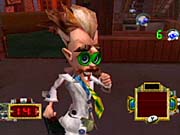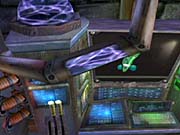Dr. Muto isn't exactly the most inspiring platforming character to be created--this mad scientist of small stature relies on a remote control device to attack enemies and wears a pair of small rocket shoes to jump around within the environment. Indeed, the game Dr. Muto is least exciting and shows most of its weaknesses when playing as its main character, but as you progress through the game, the doctor will gain the ability to change into different types of animals. It's these animal transformations that instill life into Dr. Muto's otherwise irritating combination of platforming with very strong collection elements and it does so by simply making the gameplay experience for each creature different. However, the game still has quite a few other problems, namely a horrible camera and a general lack of polish.

Dr. Muto sets out to rebuild Planet Midway, which he inadvertently destroyed with his energy device, by retrieving pieces of a device named the genitor from a series of planets, each of which has several areas where a piece of the machine could possibly be hidden. In most cases, tracking down parts of the genitor isn't all that difficult because their location is often revealed after hitting a special switch, or triggering a sequence of special events. In fact, most of Dr. Muto's gameplay focuses on hitting switches, pulling levers, or throwing small blue creatures into electrical fields by capturing them with his remote control device. This repetitive element is enhanced by the fact that some of the special devices that Dr. Muto can use, as well as his transformation abilities, require you to collect various items as you're traveling through one of the levels.
Throughout each section of a planet, you'll find blue orbs hanging in the sky or inside crates that you can smash open using Dr. Muto's attack beam. Sometimes, they'll also be hidden, so you'll have to find a special switch in order to find them, though chances are you'll discover them by accident. These blue orbs are especially important they can unlock additional animal transformation formulas.
Blue orbs aren't the only thing you need to worry about collecting. When you actually unlock one of Dr. Muto's transformation formulas later in the game, you'll see that a few requirements must be met before Dr. Muto can change into that creature. For example, Dr. Muto's ape transformation requires DNA from two types of enemies, which sounds simple (and can be in some of the later levels) but in this case you need to find dozens of these enemies. Quite a few of them can be difficult to find and you'll end up backtracking through almost the entire level in search of them. This is the exact same scenario for some of Dr. Muto's special items, which need several well-hidden special parts to function. There's a prevalent collecting element in Dr. Muto, and you'll undoubtedly want to collect just about every blue orb, piece of enemy DNA, or spare part in site so you don't have to worry about falling short of some requirement later in the game. Unfortunately, this collecting also slows down the pace of the game to the point that it just becomes tedious to continue looking for objects. In addition, some of the later levels place an emphasis on platforming and rapid movement, and as such, they aren't really conducive to the collecting element.
It's certainly worth noting that when you finally gain the ability to transform into a creature, whether it's a spider or a fish, that the game becomes much more enjoyable. Each creature that Dr. Muto can transform into play quite differently, such as the massive ape, which moves slow but has the ability to perform a massive ground stomp. Conversely, the rat is small and maneuverable but it can be crushed by rotating gears or other such environmental hazards. However, there are quite a few limitations. The game will almost always limit the animal that you can transform into in certain areas, and most of the time, the animals are only useful in specific situations and can't really be generally utilized throughout the game.
The levels in Dr. Muto start off structurally mundane as you'll generally walk down paths scattered with enemies and surrounded by invisible barriers, which can also be quite annoying as you'll briefly wonder why Dr. Muto can't jump over a certain obstacle to obtain an item. Later on, you'll start to see much more variety and levels that are generally more creative and fun to play through because they're focused much more on platforming, but this also where the camera problems start to creep up. You'll constantly be fighting the camera to get a good look at exactly which platform you're supposed to leap to next, which isn't as difficult as it is in the narrow passageways where the camera sometimes can't be moved at all.
The GameCube version of Dr. Muto looks and runs a little smoother than its PlayStation 2 counterpart, but it's doesn't exactly push the GameCube hardware. Some of the early environments sport some bland and frequently repeated textures, and there are also plenty of sharp edges that detract from the cartoon look of Dr. Muto and many of the enemies in the game. There are some nice little animations in the game--for example, when Dr. Muto uses the rocket-powered shoes, his lips will flap in the wind, and when he transforms into a fish, he'll flop around on land much like a real fish would. There are some frame rate issues in the GameCube version, but they don't seem to be as bad as in the PlayStation 2 version.

Much like the graphics, the sound and music keep in tune with the theme of the game. Dr. Muto's voice is appropriate for the character, but after hearing him say certain lines repeatedly, it can get a little irritating. The voice for Al is pretty well done and successfully executes some deadpan humor that you would expect to come out of a computer assistant. Most of Muto's gadgets use sounds that you would normally hear in an early science-fiction movie.
The ability to transform into different creatures and the fact that they play so differently from each other is Dr. Muto's best trait, but it's one that's overshadowed by other problems. The collection element makes the game feel tedious, and the camera is a constant source of frustration when making difficult jumps across a series of narrow platforms. In the end, Dr. Muto is just too bland to recommend it as anything but a rental.